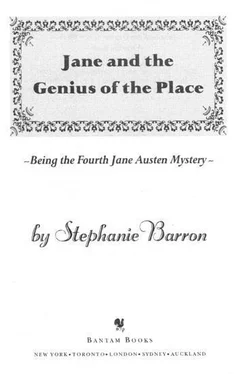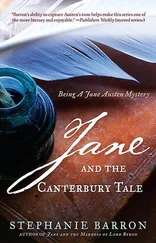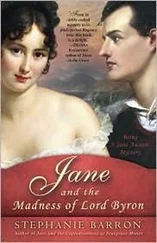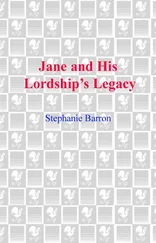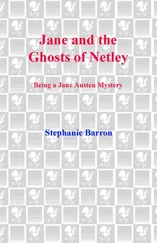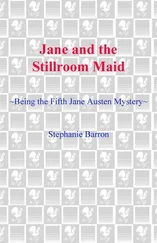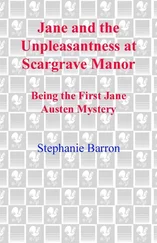Stephanie Barron - Jane and the Genius of the Place
Здесь есть возможность читать онлайн «Stephanie Barron - Jane and the Genius of the Place» весь текст электронной книги совершенно бесплатно (целиком полную версию без сокращений). В некоторых случаях можно слушать аудио, скачать через торрент в формате fb2 и присутствует краткое содержание. Жанр: Исторический детектив, Иронический детектив, на английском языке. Описание произведения, (предисловие) а так же отзывы посетителей доступны на портале библиотеки ЛибКат.
- Название:Jane and the Genius of the Place
- Автор:
- Жанр:
- Год:неизвестен
- ISBN:нет данных
- Рейтинг книги:5 / 5. Голосов: 1
-
Избранное:Добавить в избранное
- Отзывы:
-
Ваша оценка:
- 100
- 1
- 2
- 3
- 4
- 5
Jane and the Genius of the Place: краткое содержание, описание и аннотация
Предлагаем к чтению аннотацию, описание, краткое содержание или предисловие (зависит от того, что написал сам автор книги «Jane and the Genius of the Place»). Если вы не нашли необходимую информацию о книге — напишите в комментариях, мы постараемся отыскать её.
Jane and the Genius of the Place — читать онлайн бесплатно полную книгу (весь текст) целиком
Ниже представлен текст книги, разбитый по страницам. Система сохранения места последней прочитанной страницы, позволяет с удобством читать онлайн бесплатно книгу «Jane and the Genius of the Place», без необходимости каждый раз заново искать на чём Вы остановились. Поставьте закладку, и сможете в любой момент перейти на страницу, на которой закончили чтение.
Интервал:
Закладка:
9
“Caky” was the nickname Edward Austen's children bestowed on their nurse, Susannah Sackree, who was employed at Godmersham for over six decades. She often served as Jane Austen's personal maid when Jane was resident at Godmersham; she is buried at St. Nicolas's, the old Norman church just south of Godmersham Park, where Edward and Elizabeth Austen Knight are also entombed. — Editor's note.
10
It was common in Austen's day to refer to relations by marriage as though they were relations of blood. Although the term in-law existed, it was frequently used to describe step relations. — Editor's note.
11
Edward Austen Knight's male children attended Winchester College, some seventeen miles distant from his principal Hampshire estate, at Chawton. — Editor's note.
12
A cicisbeo was the acknowledged lover of a married woman. In some circles the term was used platonically, to signify a male escort. — Editor's note.
13
To call a man out was to challenge him to a duel. — Editor's note.
14
A gentleman's vowels were his IOUs — signed with his name, and binding as a debt of honor. — Editor's note.
15
Lady Susan , first drafted in the mid-1790s, was never titled or published during Austen's life. Even at the time of its composition, the novel's epistolary form was considered more appropriate to the eighteenth than the nineteenth century. Why Austen abandoned The Watsons , which she had begun in 1803 or 1804, in order to finish the more cynical Lady Susan, is a mystery; but some Austen scholars impute the decision to a persistent depression that resulted from her father's death in January 1805. Despite its flaws, Lady Susan's calculating and amoral heroine is utterly irresistible. — Editor's note.
16
The sweep, in Austen's day, was the common name for the driveway. — Editor's note.
17
From his youth, Jane's elder brother, Francis Austen, RN, was called “Fly.” He was posted to the Channel station in 1804 as captain of the Leopard , and transferred in 1805 to the Canopus , a French-built ship of the line under Admiral Lord Horatio Nelson's ultimate command. — Editor's note.
18
Warren Roberts, in Jane Austen and the French Revolution (Macmillan, 1979), relates that evacuation plans were disseminated to every household within fifteen miles of the Kentish coast. Godmersham lay some miles west of that perimeter, but perhaps its position along the retreat toward London made it worthy of the Guards' notice. Sainfoin, also known as cockshead, was a common forage plant used as animal fodder. — Editor's note.
19
Edward Austen refers here to a demand for satisfaction in a matter of honor, in which the offended party usually threw a glove at his opponent's feet or, in extreme cases, struck him with the glove across the cheek. An affair of honor was usually settled at pistol-point. If either party killed the other, the survivor could be charged with murder. — Editor's note.
20
George Canning (1770–1827) served as Undersecretary of State in 1796, and as Treasurer of the Navy from 1804–1806. As such, he had virtually no authority over naval organization or policy, which was administered by the First Lord of the Admiralty, but he was responsible for matters of naval finance in Parliament. This included the salaries of naval captains, the naval budget, and the disposition of the Secret Funds — monies set aside for the purpose of espionage, and unaccountable to Parliament. — Editor's note.
21
The House of Hope was the powerful and influential Scots banking concern based in Amsterdam. Hope financed, among other things, Napoleon Bonaparte's government and campaigns. — Editor's note.
22
William Pitt the Younger (1759–1806) was in his last months of life in August 1805. As minister of the Treasury, he was also prime minister of England. A brilliant, lonely, and calculating political genius, he was the foremost Tory of his generation and a lifelong adversary of the Prince of Wales. He was also an alcoholic, and his liver failed when he was forty-seven. He was carried, dying, from the House of Commons in December 1805, and died early in 1806. — Editor's note.
23
It was considered necessary for a coroner's jury to view the corpse, in order to form a judgment about the manner of death. This practice was later abolished, and replaced with medical examiners' sworn testimony. — Editor's note.
24
It was the practice during this period to hold enemy officers in lodgings that befit their status as gentlemen, and to exchange them for captured officers of one's own army at the first opportunity. — Editor's note.
25
Harriot Bridges's elder sister, Marianne (1774–1811), was an invalid from childhood, and was at this time bedridden. Much of Harriot's time was spent attending her, and Cassandra was assisting in the duty while resident at Goodnestone Farm. — Editor's note.
26
The projected troop movements took place on August 30, 1805, as Jane reported in a letter later written from Goodnestone Farm. — Editor's note.
27
The Romantic novel by Goethe, presumably read in the translation. — Editor's note.
28
Eastwell Park sat four miles south of Godmersham on the road to Ashford, now the A20. It was the home of the Finch-Hattons until 1893. The house designed by Bonomi was razed in 1926, and its successor is presenuy operated as a hotel. — Editor's note.
29
Those who possessed country manners (like Jane Austen's parents) generally dined around three or four o'clock in the afternoon. But stylish, fashionable people accustomed to the habits of London adopted the practise of dining at seven. It was considered dreadfully old-fashioned to do otherwise. Hence Lady Elizabeth's sense of slight. — Editor's note.
30
Lancelot “Capability” Brown (1715–1783), the supreme interpreter of the natural style in landscape gardening, transformed the English countryside in the eighteenth century. He abolished rigidly geometrical park designs, such as the formal terracing and allees of the French style then predominating, and achieved a free-flowing, bucolic terrain dotted with copses that has come to epitomize the late Georgian landscape.
A ha-ha was an elaborate livestock guard, separating the area of free-ranging parkland from die more formal garden space. It was formed of either a sunken ditch or a raised wall. Maria Bertram, in Austen's Mansfield Park , is trapped by a locked ha-ha gate at her betrothed's estate — a symbolic reference to die prison of social convention. — Editor's note.
31
It was Alexander Pope (1688–1744) who remarked that nothing could be achieved in landscape design without respect for the “genius of the place” — the governing spirit of a particular landscape. He referred to an idea first stated by Horace, that every place possessed a resident genie , that must be propitiated if Beauty was to be achieved. Pope probably intended this to mean a respect for the natural attributes of the terrain; but at times his words were interpreted quite literally as a respect for the resident god. Grottoes were built to house Pan or a water nymph, as at the great gardens of Stourhead in Wiltshire. — Editor's note.
Читать дальшеИнтервал:
Закладка:
Похожие книги на «Jane and the Genius of the Place»
Представляем Вашему вниманию похожие книги на «Jane and the Genius of the Place» списком для выбора. Мы отобрали схожую по названию и смыслу литературу в надежде предоставить читателям больше вариантов отыскать новые, интересные, ещё непрочитанные произведения.
Обсуждение, отзывы о книге «Jane and the Genius of the Place» и просто собственные мнения читателей. Оставьте ваши комментарии, напишите, что Вы думаете о произведении, его смысле или главных героях. Укажите что конкретно понравилось, а что нет, и почему Вы так считаете.
